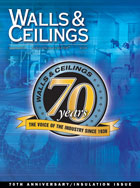

Another reason for my attachment to the magazine is that I left our industry for a year and thought I may never return. I missed the people, the challenges and being part of something important: wall and ceiling construction. This magazine, the voice of the industry, offered me a chance to stay connected.
The final and most important reason is the future. I believe that W&C magazine will become more relevant to the industry than ever before. The W&C staff is constantly searching for new ideas and how to keep the readers abreast of current important and relevant topics, innovations, trends and changes. In today’s litigious society, contractors, dealers and manufacturers have to stay on top of these trends and abreast of changes as soon as they happen. Today, things happen fast, very fast and you can’t afford to be late or you may find yourself out of business. Blackberry and I-phones make fax machines look like an eight-track tape player.
THE LAST SEVEN DECADES
You have seen a lot in your 70 years my old friend. There were other magazines for plastering back then, but only you survived. You remember button board, gun cement, acoustical “popcorn” ceilings and lathers that “mouthed blues.” Mouthing blues was not an imitation of Dan Akroyd and John Belushi in the Blues Brothers but a construction technique. Before pneumatic tools took hold, interiors of gypsum lath were applied by hand using 4d blued nails. The nails came in a keg wrapped in wax paper and the bluing was for hygiene. On the site, the lather would throw a handful of the blue nails into his mouth and spit them out as needed. When I was a boy, it was something to watch. These guys were good-they spit the nail toward the board and nailed it into the lath in a single seamless motion. Every once in a while, you would hear about a guy who inadvertently swallowed a nail and would have to be taken to the emergency room. The lathers would also develop a bluish ring around their lips.
Drywall went through some changes too. In the beginning, the taping and hiding of joints was pretty poor and plasterers thought the system would certainly die out. The “Knock on the Wall” campaign was an attempt to thwart drywall. However, the wallboard hangers got faster and the finishing techniques kept improving until drywall eventually became the dominant interior product. While you may think it was inevitable, in Europe skim coating plaster is still more dominant than joint treatment to this day.
Europe had its problems right after World War II; buildings needed to be re-built, energy was scarce and a lack of skilled tradesmen made it necessary to come up with good alternatives to traditional construction. A clever inventor came up with a method to insulate the walls from the outside and provide the same traditional plaster looking finish; EIFS was born and soon immigrated to North America. At one point it looked as though EIFS might take over cement stucco completely, however today they co-exist as both great options for the designer and contractor.
A lot of change has happened and who knows what the future holds for plaster, drywall, metal framing or ceilings, but be assured W&C will be first to let you know about it. With integrity and some forward thinking, we can all make sure the next 70 years are good for the wall and ceiling industry and in turn good for our children.



Report Abusive Comment